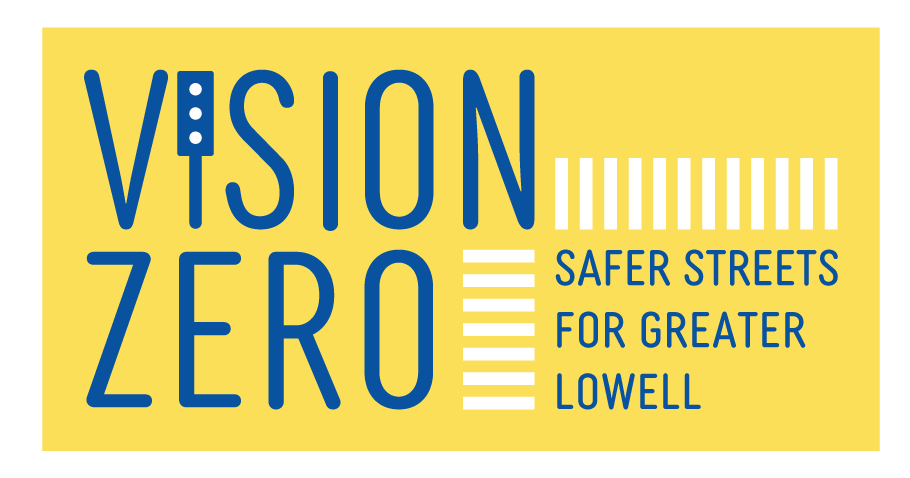Vision Zero
Safer Streets for the Greater Lowell Region
On July 24, 2024, the Northern Middlesex Metropolitan Planning Organization (NMMPO) voted to endorse Greater Lowell Vision Zero as the region’s Safety Action Plan. Informed by extensive public outreach and engagement, Greater Lowell Vision Zero includes key strategies and performance metrics to measure annual progress on reducing serious injuries and fatalities. By adopting the plan, the NMMPO is committed to achieving zero roadway fatalities and serious injuries by 2050. The plan's approval also positions NMCOG’s member municipalities (Lowell, Billerica, Chelmsford, Dracut, Dunstable, Pepperell, Tewksbury, Tyngsborough, and Westford) to access capital funding through the Safe Streets and Roads for All (SS4A) Grant Program.
View translations of the Executive Summary:
View the Vision Zero Dashboard for the Greater Lowell region.
Project Background
In 2022 the Northern Middlesex Council of Governments (NMCOG) was awarded a Safe Streets and Roads for All (SS4A) grant in partnership with the Merrimack Valley Planning Commission. The SS4A program funds regional initiatives through grants to prevent roadway deaths and serious injuries. The foundation of the grant program is the development of a Vision Zero Action Plan, which can be developed at a municipal or regional level. Vision Zero plans include explicit goals and measurable strategies to implement and address the region's safety challenges, as well as timelines and identified projects to guide future projects and eliminate traffic-related deaths and injuries throughout our communities. The SS4A program supports the U.S. Department of Transportation's National Roadway Safety Strategy and our goal of zero roadway deaths.
NMCOG led the effort in partnership with the NMMPO and the Vision Advisory Committee, a group of dedicated community members and municipal staff from the region tasked with collaborating on developing, implementing, and monitoring a regional safety action plan.
For questions related to this plan, please contact Kelly Lynema, Deputy Director.
Core Principles
Vision Zero is not just a mere campaign; it's a bold initiative to eliminate all traffic-related fatalities and severe injuries. Together, we can make our community a place where every journeys are safe.
Greater collaboration among local traffic planners, engineers, policymakers, and public health professionals is needed to prevent traffic deaths. Vision Zero brings together diverse and necessary stakeholders to address the complex road safety problem.
The 10 Core Elements identify the most impactful focus areas underlying an authentic Vision Zero approach. This includes a focus on speed management; proactive, predictive planning; and elevating equity and meaningful community engagement to guard against unintentional consequences. This plan is designed to help communities work toward tangible and equitable results, benchmark progress toward safety, and ensure accountability. Communities will receive assistance from NMCOG in the following core areas as part of the development of the Vision Zero Greater Lowell Plan.
-
1. Public, High-Level, and Ongoing Commitment. Key elected officials (Mayor, Select Board, City Council members) and leaders within public agencies, including transportation, public health, and police, commit to a goal of eliminating traffic fatalities and serious injuries within a specific timeframe. Leadership across these agencies consistently prioritizes safety via a collaborative working group and other resource sharing efforts.
2. Authentic Engagement. Meaningful and accessible community engagement toward a Vision Zero strategy and implementation is employed, with a focus on equity.
3. Strategic Planning. A Vision Zero Action Plan is developed, approved, and used to guide work. The Plan includes explicit goals and measurable strategies with clear timelines and identifies responsible stakeholders.
4. Project Delivery. Decision-makers and system designers advance projects and policies for safe, equitable multimodal travel by securing funding and implementing projects, prioritizing roadways with the most pressing safety issues.
-
5. Complete Streets for All. Complete Streets concepts are integrated into communitywide plans and implemented through projects to encourage a safe, well-connected transportation network for people using all modes of transportation. This prioritizes safe travel of people over expeditious travel of motor vehicles.
6. Context-Appropriate Speeds. Travel speeds are set and managed to achieve safe conditions for the specific roadway context and to protect all roadway users, particularly those most at risk in crashes. Proven speed management policies and practices are prioritized to reach this goal.
-
7. Equity-Focused Analysis and Programs. Commitment is made to an equitable approach and outcomes, including prioritizing engagement and investments in traditionally under-served communities and adopting equitable traffic enforcement practices.
8. Proactive, Systemic Planning. A proactive, systems-based approach to safety is used to identify and address top risk factors and mitigate potential crashes and crash severity.
9. Responsive, Hot Spot Planning. A map of the community’s fatal and serious injury crash locations is developed, regularly updated, and used to guide priority actions and funding.
10. Comprehensive Evaluation and Adjustments. Routine evaluation of the performance of all safety interventions is made public and shared with decision-makers to inform priorities, budgets, and updates to the Vision Zero Action Plan.
Safe Systems Approach
The purpose of using a Safe Systems approach in Vision Zero Planning is to design and operate our vehicles and infrastructure that anticipates human error and accommodates human injury tolerances to reduce fatal and serious injuries. This is a shift in transportation planning by establishing a human-centered approach and proactively reducing fatalities and serious injuries. The key principles of the approach are:
People make Mistakes
People are Vulnerable
Safety is Proactive
We will adopt a safety culture in adopting a Safe Systems approach for our region. Safety culture can be defined as the shared values, actions, and behaviors that demonstrate a commitment to safety over competing goals and demands. Regular progress can be made by placing safety first and following Safe Systems principles in the daily large and small decisions that confront us.
Vision Zero is our target. Safe systems is our approach for reaching that target. Safety Culture includes the values, beliefs, and attitudes shared by stakeholders that ensure we succeed together.
In the News





